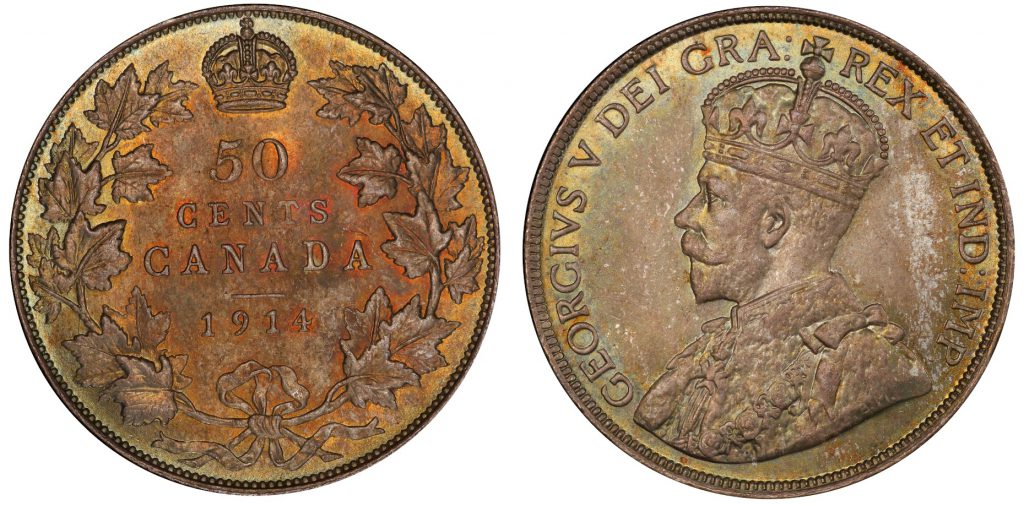By Jesse Robitaille
Realizations include buyer’s premium.
With results indicative of a strong market, the five-session Torex Auction held in conjunction with the long-running show in Toronto realized more than $1 million across 2,500 lots this October.
About 90 per cent of the lots were sold in the recent auction hosted by The Canadian Numismatic Company (TCNC), with coppers, 25-cent coins and silver dollars leading the way.
“Paper money session was strong as usual, but overall, coins were stronger than usual,” said auctioneer Marc Verret, who added the “high-end modern coins did extremely well.”
A pair of collections – the Kingston Collection of Canadian Coins and the third part of the Paris Collection of Copper Coins – were offered alongside other selections from nearly 80 consignors across North America.
While floor attendance was “a bit weak,” Verret said mail and online bidding was “very strong.”
“We’re very happy with the results. The market is very strong.”
COINAGE
Session two, which offered Canadian and Maritimes coinage, saw several top-earning highlights.
A 1914 half-dollar in Professional Coin Grading Service (PCGS) and International Coin Certification Service (ICCS) Mint State-66 was offered as Lot 850. It the highest-graded example from both third-party grading services, with no examples certified higher than MS-65 by ICCS.
It brought $76,375.
Another fine example, an 1893 25-cent piece in ICCS MS-64 was offered as Lot 775. Described by auctioneers as a “razor-sharp, full-white example” and “one of the best and finest examples ever handled and seen by TCNC,” it was part of the West Country Collection.
It brought $8,925.

A 1936-dated 25-cent ‘dot’ coin in PCGS MS-64 brought $5,057 as Lot 794 of the five-session Torex Auction this October.
25-CENT ‘DOT’ COIN
A 1936-dated “dot” coin, this a 25-cent piece in PCGS MS-64, was offered as Lot 794.
Described by auctioneers as having “delicate tones over full underlying lustre,” the rare variety dates back to the December 1936 abdication of King Edward VIII.
After ruling for less than a year, Edward VIII became the first English monarch to voluntarily abdicate the throne during a speech broadcast across Britain on Dec. 11, 1936. He wished to be free to marry the twice-divorced U.S. socialite Wallis Simpson.
Described by the BBC as a “historic broadcast and climax of the constitutional crisis,” Edward’s abdication also caused a coin shortage in Canada that led to the 1936 “dot” coins.
In early 1937, met with a lack of circulating one-, 10- and 25-cent coins, officials decided to use the previous year’s coinage – bearing the portrait of former King George V – but added a small dot to the dies to denote them as 1937 issues.
The example offered this October by TCNC sold for $5,057.
‘OUTSTANDING STRIKE’
A 1914-dated 25-cent coin in PCGS MS64-plus was also offered during session two.
Described as an “outstanding strike and eye-appeal,” this piece crossed the block as Lot 785 and brought $4,105.
From the Paris Collection, an 1899 one-cent “Repunched 9” variety in ICCS MS-66 Red was offered as Lot 560. Described by Verret as “very difficult to find” in Gem condition, it brought $3,272.
Another cent, this dated 1925 and certified by ICCS as MS-64 Red, was offered as Lot 584. It brought $3,272.
Again from the Paris Collection, a 1910 cent in ICCS MS-66 Red was offered as Lot 574. Described as a “very flashy example with strong lustre,” it brought $2,467.
Rounding out the coinage highlights was a 1953 one-cent “No Shoulder Fold” variety in ICCS MS-66 Red. Offered as Lot 592, it brought $773 – nearly seven times its pre-sale estimate of $130-$160.
PAPER MONEY
Moving on to paper money, which was offered during session one, a 1935 $1,000 banknote (BC-19) released as part of the Bank of Canada’s first-ever issue was offered as Lot 304.
With a serial number reading “#A12923” and certified by Canadian Coin Certification Service as Gem Uncirculated-65, it was described by Verret as “a splendid example, one of unforgettable quality and a highlight of this sale.”
It brought $21,420.
A pair of French proofs (BC-18FP) from the 1935 Series was also offered as Lot 311. For the series’ $500 denomination, both proofs were certified by Legacy Currency Grading (LCG), a new third-party paper money grading company led by Jason Bradford, who’s the former president PCGS Currency. They’re certified as Superb Gem Uncirculated-68 PPQ (premium paper quality).
Together, they brought $9,817.
Another pair of proofs for the 1935 Series’ $1 note (BC-2FP) was offered as Lot 306 and brought $6,960.

A rare $10 ‘Devil’s Face’ replacement note from the 1954 Series brought $9,520 as Lot 359. It was certified by Legacy Currency Grading as Choice Uncirculated-63 PPQ (premium paper quality).
From the 1954 Series – also known as the multi-coloured series – a $10 note (BC-32BA) was offered as Lot 359. With a serial number reading “AD00008218,” the rare “Devil’s Face” replacement was also graded by LCG as Choice Uncirculated-63 PPQ.
Described by Verret as “crisp, fresh and fully original,” the note brought $9,520.
Another LCG-graded example, this a 1923 $1 “purple seal” note (DC-25K) in Gem New Uncirculated-64 PPQ, was offered as Lot 270. With a serial number reading “YC6317031,” the note is described by Verret as being “among the best of the best … with nice eye-appeal, good margins and superb embossing.”
It brought $9,400.
Rounding out the paper money highlights is Lot 392, a 1986 $5 note (BC-56A-I) with the “EPW” prefix, which is the rarest of all the 1986 $5 prefixes.
With a serial number reading “EPW9698865,” it was described by auctioneers as “quite rare and underrated” and brought $3,867.
For more information about the recent auction, visit canadiancoinsandpapermoney.com.




